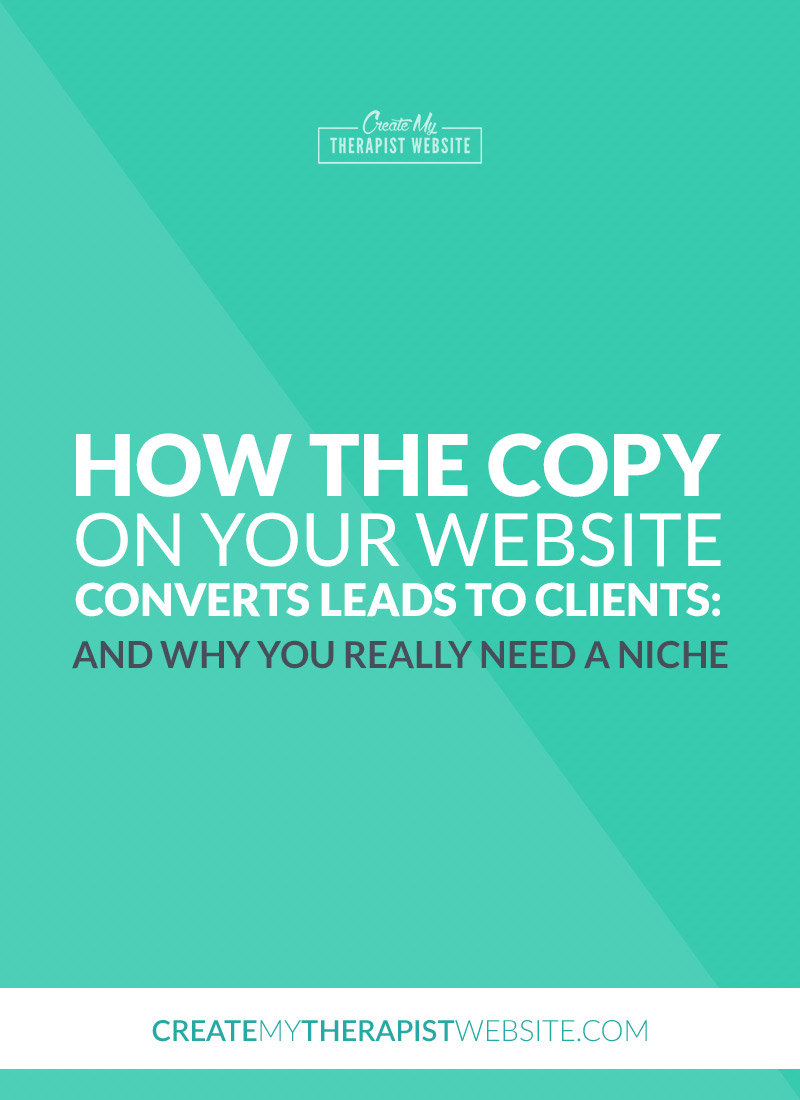I hate to say it, but as clinicians, we can be a little slow on the entrepreneurial uptake. We’re often so focused on serving our clients well, that we struggle to come up for air and think about the professional side of our practices.
And, because we sometimes forget that we’re running a business as well as serving others, it’s not uncommon for those in the psychotherapy profession to neglect business-building activities.
For instance, the idea of incorporating or even relying on technology in our practices is still a bit scary and there is a definite tension when it comes to clinicians embracing modern ways of networking and marketing.
In fact, I literally get questions daily about how online marketing works and whether or not a fellow therapist actually needs a website.
As 2017 draws to an end and we approach 2018, the answer is an unwavering and astounding YES!
Yes, you need a website. But not only that, you need a well-designed website that is both visually appealing and speaks directly to your ideal client.
Now, I’m “technically” a millennial so my willingness to embrace technology may be a bit skewed, but I’m being really honest when I say that even my 90-year-old grandma has an iPhone.
This goes to show that no matter your ideal client population, they are online.
Your website is your greatest business asset.
It’s inexpensive to maintain and it works for you 24/7. Sure, there is an initial cost to set up a website properly, and whether you hire it out or create it yourself, there is a large commitment of either money or time up front.
But take that money you spend and divide it into an hourly wage, and you’ll see that your website is actually your most underpaid employee.
Your website is also your greatest gatekeeper.
When your content is written in a way that speaks directly to your ideal client, you will not only attract them to your practice but repel those that are not a good fit.
The same goes for posting your hours and fees online. Those who cannot fit into your schedule or afford your fees will move on. But, the calls that do come will be serious and motivated inquiries.
Perhaps the best thing about having a well-designed website, however, is the fact that it is a marketing machine.
I’m a big fan of in-person networking and believe it’s essential to growing and scaling any practice.
But, it’s just not possible to meet in person 24-hours a day. What’s more, a client in need whose anxiety has him up at 3 in the morning can’t go in and see his primary care doctor.
So, who better to turn to than good ol’ Google?
Having an attractive website allows you to still be available despite the time of day or circumstances. It also provides you with an internet home base which acts as the hub of your online marketing.
The Truth About Content and Online Marketing
By now, we are well aware that we must market our practices to see any kind of success.
There are just so many professionals in our field, that without a concentrated effort, we will never stand out from the crowd.
However, many of the traditional ways we are taught to promote ourselves: in-person networking, business events in the community, forming partnerships with doctors and psychiatrists, hosting open houses, etc. all demand so much effort that they leave little time for us to concentrate on what we do best – therapy.
The truth about internet marketing is that any AND everything that is posted online counts as content.
This includes the raging rant we posted five years ago after being pulled over for a broken taillight when there are “real” criminals out there. And, it also includes the picture from last week where we are shaking hands with the police chief after implementing a mental health system in the county jail.
Though hilarious (or mortifying – however you want to look at it), what’s difficult about marketing in 2017 and beyond is that nothing ever disappears from the internet.
If it’s been posted somewhere, whether immediately “deleted” or not, it is accessible by someone, somehow. This means that all of the content we have ever created contributes to our online reputation and our web presence.
The fortunate thing, though, is that content is cumulative. So, the more positive things you post about yourself personally and professionally, the better your reputation becomes.
This strategic curation of online content that highlights you and your practice in a positive way becomes what is known as your “brand.”
Positioning your brand’s message so it is easily accessible by those that most need your help is what is known as content marketing.
Content Marketing is an extremely powerful tool for attracting clients and building a practice with much less effort and overhead than ever before.
Utilizing blogs, videos, images, and website copy allows therapists to highlight themselves among all other clinicians in the area and position their practice as the one that is the best match for those needing services.
What’s more, recent surveys show that technology such as the internet and Smart Phones are not commodities.
Regardless of their socioeconomic status, clients are online.
Therefore, content marketing is one way to reach populations that might not ever find their way to therapy through traditional channels.
Lastly, content marketing is a fervent way for us to build practices we truly love and are excited about showing up to every day.
How Your Website Fits into A Content Marketing Strategy
Like I mentioned above, your website is the hub of your presence online.
It is where your brand lives and where all of your potential clients should be going to find out more about working with you.
The first impression, which is almost always visual, is what keeps these potential leads from immediately bouncing away from your site.
However, it is the web copy (read: content) that draws the reader in and converts them from a prospect to a paying client.
There are a few different ways a lead might land on your website.
They may find you directly by putting keyword phrases into a search engine, they may find your website listed on a directory, or they may stumble across your business or rack card.
In each of these cases, the prospect is what is considered a “cold” lead. They do not know you, and they have not received your name or contact information from anyone they trust.
Once they have found you online, the only thing cold leads have to go on when deciding whether or not you are a good fit for them is the copy on your website.
How you speak to potential clients has a profound effect on whether or not they pick up the phone to schedule with you. Talking directly to leads in a language that resonates will cause them to have an emotional reaction and believe that you truly understand what it is they are struggling with.
Ensuring that your website is filled to the brim with such tailored content is the quickest way to earn a prospect’s trust and encourage them to get in contact with you.
And it’s not much different for warm leads.
These are the people who come to your website through a referral. Whether they receive your name from a trusted doctor or loved one, in this day and age, the majority of people will still go to your website to learn more about you.
While warms leads are a bit more primed to schedule with you, they can still be turned off if they don’t believe that you are the right fit for them.
Talking in too general of a way is just not helpful. Without reaching leads at a core level, you will always leave readers of your website in a lukewarm state.
But, if you’re able to get to the core of the prospect’s struggles, and speak to them on each and every page of your site, you can elicit an emotional response and motivate them to pick up the phone.
So, what’s the key to speaking in a way that resonates with potential clients?
Choosing a niche.
What is Niche Marketing and Why Should Therapists Use It?
The idea of defining your niche is still a bit controversial in clinician circles.
One reason for this is there are some that think niching down is unethical as therapists who prefer a certain population are essentially denying services to some who may be in need.
The idea, however, is not to deny services, but to offer therapy at a higher skill level.
In fact, defining your ideal client allows you to hone your skills and become a specialist. So long as you are providing legitimate options and alternatives to those outside your niche, such as genuine referrals, you are not violating any ethical guidelines.
Another common hang-up about niching down is that some therapists believe it to be too restrictive to build a thriving practice.
It’s true, the second you decide to niche your practice, you are basically choosing to alienate a large segment of potential clients. By narrowing your focus to one slice of the population, you are effectively telling others that you do not serve them as well as you serve your chosen demographic.
This can be really scary, especially when clinicians are new to practice or do not have a full caseload.
But the reality is, defining your niche is the quickest way to fill a practice with clients you are excited to work with and that leave you feeling professionally fulfilled.
Incorporating niche marketing into your practice is the best way to write “tight” website copy.
Copy that is too loose or that has too many holes in it will not speak to your ideal clients. It gives them too many opportunities to turn their attention elsewhere.
However, web copy that is written with a niche in mind becomes sharp and provocative and resonates with readers at their core.
A Five-Step Niching Process
So now that you know the importance of your website and also how integral your web copy is to attracting your ideal client, it’s time to figure out how to go about defining your niche.
A lot of clinicians make the mistake of having a niche that is too wide.
Again, this probably goes back to the fear of repelling too many clients and operating from a scarcity mindset.
However, there are enough clients for every therapist to build a profitable practice, so there should be no fear about learning to attract a very narrow segment of the population.
A great tip is to imagine the act of defining your niche as building an upside-down pyramid.
The objective is to work from a wide scope and funnel the concept of your ideal client down until it becomes narrower and narrower.
At each stage, ask yourself questions about your ideal client like “what is at the core of their presenting problem” “what is underneath this complaint” and “what is really going on here” to help you really learn how to target them.
I always recommend going through this process five times so that you essentially narrow your niche down five levels.
An example of this is:
- Teenagers
- Teenagers whose grades have suddenly dropped
- Teenagers whose grades have suddenly dropped because they have developed test anxiety
- Teenagers whose grades have suddenly dropped and who have developed test anxiety because they are worried about getting into a good college
- Teenagers whose grades have suddenly dropped, who have developed test anxiety, and who are worried about getting into a good college because their older sibling graduated Suma Cum Laude from an Ivy League school
By the time you get to the fifth level, you have a completely clear idea of who you are marketing to and trying to attract to your practice.
Now, that does not mean that this is the only type of client you will see.
Some of your marketing will appeal to 20 or 30 somethings with anxiety or the parents of high-performing teens, but the core of your marketing message will resonate with a certain segment of the population which is the whole point.
This exercise isn’t always easy to do right off the bat and takes some practice, but once you get the hang of it, it can be fun to brainstorm different ideal client populations you’d like to serve.
If you need a little guidance when it comes to refining your niche, don’t worry, I’ve got you covered.
If you’d like to take your content marketing even further, by defining your ideal client, finding your ideal clients online and generating strategic, tailored website content, download your FREE 8-page workbook here >>> bit.ly/cliniciancontentworkbook
About Marissa Lawton
Marissa Lawton is a licensed counselor, national board certified counselor, and member of the American Counseling Association. She is also an avid content marketer and lights up helping female clinicians build their private practices through strategic and tailored online marketing.
Marissa is the creator of The Clinician’s Guide to Content Marketing, a comprehensive system of masterclasses, concierge strategy calls, and boutique writing services that helps therapists identify their niche, find them online, and generate content that speaks directly to their ideal clients.
You can learn more about Marissa at risslawton.com




